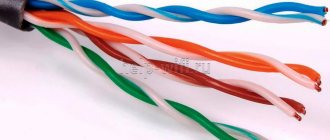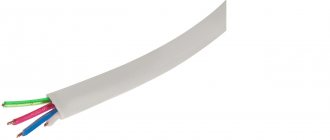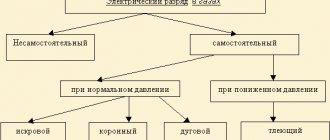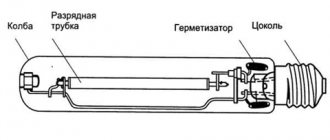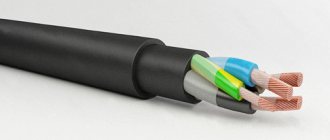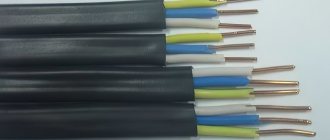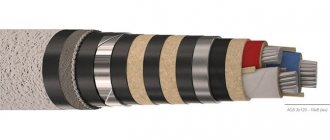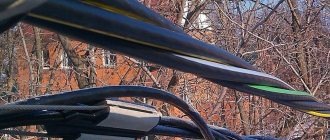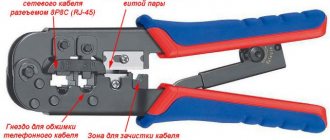Differences between PVS and VVG. Table 1
| Cable criterion/brand | PVS | VVG |
| Lived | Copper multi-wire | Copper mono- or multi-wire |
| Degree of core flexibility | High (grade 5) | Secondary (grade 1-2) |
| Number of cores | 2-5 | 1-5 |
| Core cross-section, mm2 | 0.75-2.5 | 1.5-625 |
| Winding | — | Non-woven fabric |
| Operating voltage, V | ||
| — alternating current (50 Hz) | 380 | 660/1000 |
| - direct current | 660 | 1600/2400 |
| Operating temperature, °C | -25 to + 40 | -50 to + 50 |
| Limit core heating temperature, °C | 70 | 80 |
| Service life, years | 6-10 | 30 |
The use of such cable brands as PVS or ShVVP, as a rule, does not go beyond the domestic sphere, which is facilitated by their increased flexibility (class 5), as well as the maximum operating voltage, which is limited to 380 V AC and 660 V DC.
The PVS connecting wire has proven itself to be an excellent extension cable, as well as when installed in special boxes or inter-device installation. The VVG brand meets the requirements of industrial standards and is distinguished by an extended operating temperature range, -50/+50 °C, and an impressive period of uninterrupted operation, up to 30 years, which allows the creation of durable permanent connections. VVG cable is allowed for installation in blocks and on special overpasses, on bridges and in mines, inside dry and damp rooms, incl. under concrete and plaster, in fire and explosion hazardous areas, on land and in water bodies, at an altitude of up to 4.2 km above sea level and in places with increased vibration.
Technical characteristics and operating conditions
According to the current GOST, this type of wire must meet the following standards:
- The lower limit of the operating temperature range is 20°C below zero, permissible long-term heating is 40-50°C, short-term heating is not more than 70°C. Frost-resistant design is possible, in this case the lower threshold drops to -40°C.
- The rated voltage is 380 V, but the insulation must withstand a short-term increase of up to 2000 V (at least 5 minutes). It is under these conditions that tests should be carried out by the manufacturer.
- PVA insulation of any type should not spread fire if a single installation was carried out. When laying in groups, this requirement applies only to wires marked “ng” in the marking.
- Failure-free operating time in hours is at least 5000; when used in stationary installations, this parameter increases to 12000; in years this is 6 and 10 years, respectively.
- The threshold of permissible relative humidity should not be lower than 98%.
- Mandatory resistance to the destructive effects of fungi and mold.
The remaining parameters are shown in the table below.
Which cable, PVS or VVG, is better for an apartment?
The cable that comes from the distribution box to the apartment switchboard is usually one of the varieties of the three-core VVG brand.
We recommend that you read the article “Cable for laying in an apartment.”
When creating a stationary wiring for an apartment electrical network, it is better to use a VVG cable, due to a greater safety margin in terms of electrical and functional characteristics. However, when laying wires in boxes and baseboards, especially in places that require significant bending of the product, many electricians work with PVA. It should be taken into account that PVS can withstand less load than VVG and this is the indirect purpose of this wire, although there is no strict prohibition in the PUE for laying PVS wire in an apartment.
Accepted colors
The above GOST does not impose any special requirements for the coloring of external insulation; 10 color options are allowed: white, black, gray, etc.
As for the color of the core insulation, it must correspond to the table below.
The color chart for insulation is live depending on their purpose and quantity:
| Number of cores | Accepted color standard | |
| there is a grounding conductor | No grounding conductor | |
| 2 | brown, blue | |
| 3 | yellow-green, brown, blue | black, brown and blue |
| 4 | yellow-green, black, brown, blue | blue, black, brown, black or brown |
| 5 | yellow-green, blue, black, brown and black or brown | blue, black, brown, black or brown, black or brown |
The purpose depending on the color of the insulation is shown in Figure 3.
Colors according to GOST for neutral, protective and phase conductors
Please note that sometimes the insulation of the phase conductor is also white, which is acceptable according to the international standard.
Having finished with the design features and color designation, let's move on to the description of the main parameters.
Which brand, PVA or VVG, is better for the home?
The power supply diagram of a house, in particular a wooden one, has a number of specific features, for example, a relatively large length of wiring, the need for outdoor cable laying and its entry into the house, etc.
To enter the house, use a VVG cable with a cross-section of 16 mm2 in a metal pipe.
More detailed information in the article “Cable for a wooden house”
For internal hidden wiring in a wooden house, it is necessary to lay the cable in metal pipes. The best option is the VVG cable; PVS is not prohibited, but let us remind you that its main purpose is for non-stationary installation.
For internal open wiring on insulators or in a cable duct, you need a non-flammable cable marked -ng, for example, VVGng.
Design
Modern PVA wire consists of several intertwined copper wires with separate insulation made of high-quality polyvinyl chloride. Additionally, all conductors are protected by a PVC sheath. The standard cable has a round cross-section, although the PVSP model, as described above, will have an oval cross-section. Insulating materials may include various additives that give them additional protective functions (for example, the product does not support the combustion process).
Each copper core contains a large number of copper wires. When twisting each one, a dense rope is formed. In accordance with GOST, the class of lived in PVA must be at least fifth. Such a standard automatically regulates the minimum thickness of the wires from which a separate core is formed.
If the cross-section of each core in the cable is 1 sq. mm, then the diameter of the wires used should not be lower than 0.21 mm.
According to the standards specified in GOST, the wire can be produced in the following versions: with two, three, four or five cores. The cross-sectional area varies between 0.75-16 square meters. mm. Thicker types of cable are produced in specialized factories and are necessary for industrial use.
Analyzing GOST, you can discover another important rule: in PVA, the cores are twisted in the left direction, but the density is so high that filler is not used.
When choosing an insulating shell, manufacturers try to use materials of different colors, which simplifies installation tasks. Individual wires can be colored blue, brown, red, yellow or even yellow-green. The phase conductor is usually marked brown or red, the neutral conductor is blue or cyan, the ground conductor is double, yellow-green. The common sheath, under which all the cores are located, can have an arbitrary color (for example, black).
The top, outer layer is a polyvinyl chloride shell, which is applied using the extrusion method. During the single installation process, the protective layer does not support combustion. Due to its plasticity, the sheath fills any gaps formed between the cores, making the wire round in shape. The maximum eccentricity value is 10%.
Which brand, PVS or VVG is better for the street?
PVC insulation and sheathing of the VVG brand are characterized by increased resistance to the corrosive influence of the environment, the product is not afraid of low and high temperatures, as well as their sudden changes, and is well resistant to direct sunlight, but when protected from the sun by corrugation, it will last much longer. In principle, VVG is suitable for stationary open street wiring.
More detailed information about outdoor cable laying in the article “Cable for the street”
The shell material of PVA and VVG is the same, so the UV resistance is similar. PVS wire is used for street carrying and connecting mobile electrical equipment on the street; its service life during active use is no more than 3-5 years. At temperatures below -25 C, due to the small thickness of the insulation, the PVA wire becomes tanned and may crack.
Application area
Extensions or carriers
The main area of application and purpose of the conductors discussed are extension cords. Moreover, if the extension cord will be used in difficult conditions (at a construction site, in a garage to connect power tools), it is better to choose a PVA wire. In this case, frequent kinks and random impacts and friction are typical, so it is important that the conductor has high-quality and thick insulation.
If the extension cord will be laid somewhere behind furniture or in another way, where the likelihood that it will be crushed or other damage will occur is minimal, then it is quite possible to choose a ball screw cord. It will be more convenient to lay it or place it in narrow places due to its smaller size. Such extension cords are used when the outlet is located in an inconvenient place, as well as to connect several electrical appliances installed in one place, for example, a TV, media player and speaker system.
Let's talk about what is better for an extension cord: PVS or ShVVP wire. Generally speaking, PVA extension cord is used where frequent impacts or damage are likely. It is also better suited for connecting powerful electrical equipment, for example, hammer drills, grinders, or even some technological devices such as heat guns, provided that there is no direct contact of hot air flows or parts of the device with the wire itself.
ShVVP are used for those extension cords that do not connect powerful devices. They are better suited for connecting small kitchen equipment, lamps, electric shavers and consumer electronics.
We talked about how to make an extension cord with your own hands in the article. Check out the material to make a reliable extension cord for connecting household appliances.
Which brand, PVA or VVG, is better to use for connecting stoves and other household appliances?
Connecting household electrical appliances is usually done by bending the cable multiple times. In addition, there is a possibility of pinching and stretching of connecting and extension cords. Therefore, to connect household electrical appliances, it is better to use the PVS cable brand.
Read our article “Cable for electric stove”
Detailed description of SHVVP
To understand which ball valve cable to buy, you need to familiarize yourself with the general technical characteristics of the cable and the features of each model.
What kind of lighting do you prefer?
Built-in Chandelier
- temperature at which the ball screw can be operated (-25°С +40ºС);
- permissible air humidity at positive levels is 98%;
- set (nominal) frequency – 50Hz;
- installed (nominal) AC voltage – up to 380V;
- operating voltage – 400 volts;
- peak voltage – 200V;
- permissible core heating temperature - +70°C;
- temperature at which the cable can be laid without additional heating – (-15ºС);
- the arrangement of the cores is parallel;
- cores (section) – from 0.5 mm² to 4 mm²;
- bending radius (permissible) – 30mm;
- operation without changing technical characteristics – 5000 hours.
The price of SHVVP depends on the number of cores in the cable and their cross-section. Wholesale sale of ball-type cables allows the buyer to significantly reduce budget funds.
Let's sum it up
What has been said can be summarized as follows. Each of the materials considered has specific application features. When choosing conductors for specific purposes, you should carefully understand the difference between VVG and PVS. In conclusion, I would like to list a couple more aspects that may influence the choice.
The first aspect is price. It is possible that a lower price will determine the choice in favor of one material or another. In this case, it is necessary to accurately weigh all the disadvantages that are acquired with a gain in price.
The second aspect is design features. The cable can be flat, which in some cases creates additional convenience during installation. The wire, in turn, being softer, fits more conveniently into cable channels.
Finally, we recommend watching the video, which presents the opinion of experts:
We hope the information provided helped you understand what is better to choose for electrical wiring: PVS or VVG and what is the difference between the two brands of conductor products under consideration!
Expert opinion
It-Technology, Electrical power and electronics specialist
Ask questions to the “Specialist for modernization of energy generation systems”
PVS or VVG: which is better to choose and what is the difference? Analogs of high-temperature cable include PVSng-LS; it is actively used in wiring with increased fire safety requirements. Ask, I'm in touch!

